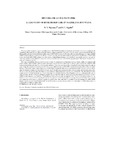| dc.identifier.citation | Ngwenya, B.N. & Kgathi, D.L. (2006) DS and access to water: a study of home-based care in Ngamiland, Botswana, Physics and Chemistry of the Earth, Parts A/B/C, Vol 31, Issues 15-16, pp. 669-680 | en |
| dc.description.abstract | This case study investigates access to potable water in HIV/AIDS related home-based care households in five rural communities in Ngamiland, Botswana. Primary data collected from five villages, consisted of two parts. The first survey collected household data on demographic and rural livelihood features and impacts of HIV/AIDS. A total of 129 households were selected using a two-stage stratified random sampling method. In the second survey, a total of 39 family primary and community care givers of continuously ill, bed-ridden or non-bed-ridden HIV/AIDS patients were interviewed. A detailed questionnaire, with closed and open-ended questions, was used to collect household data. In addition to using the questionnaire, data was also collected through participant observation, informal interviews and secondary sources. The study revealed that there are several sources of water for communities in Ngamiland such as off-plot, outdoor (communal) and on-plot outdoor and/or indoor (private) water connections, as well as other sources such as bowsed water, well-points, boreholes and open perennial/ephemeral water from river channels and pans. There was a serious problem unreliable water supply caused by, among other things, the breakdown of diesel-powered water pumps, high frequency of HIV/AIDS related absenteeism, and the failure of timely delivery of diesel fuel. Some villages experienced chronic supply disruptions while others experienced seasonal or occasional water shortages. Strategies for coping with unreliability of water supply included economizing on water, reserve storage, buying water, and collection from river/dug wells or other alternative sources such as rain harvesting tanks in government institutions. The unreliability of water supply resulted in an increase in the use of water of poor quality and other practices of poor hygiene as well as a high opportunity cost of water collection. In such instances, bathing of patients was cut from twice daily to once or not at all. Depending on the severity of HIV/AIDS related symptoms, e.g. diarrhoea, 20-80 additional litres of water could be required daily. The case study demonstrates that, at individual level, access to water is an integral element of the patient's holistic healing process and psychosocial well being. At household and community levels, access to sufficient supplies of potable water when and where it is needed is central to mitigation of HIV/AIDS impacts. Access to water should therefore not be treated strictly as an economic good due to its importance as a basic human need, a social good and indeed a human right. | en |

